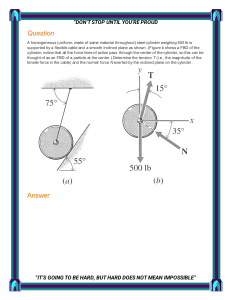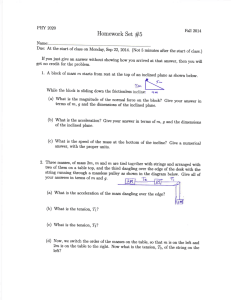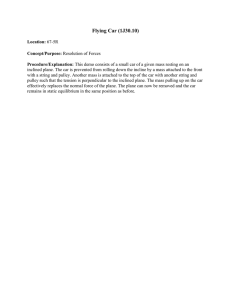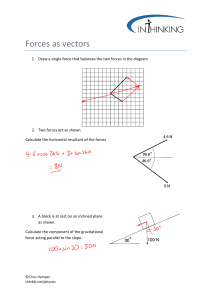Newton's First Law Examples: Physics Problems & Solutions
advertisement
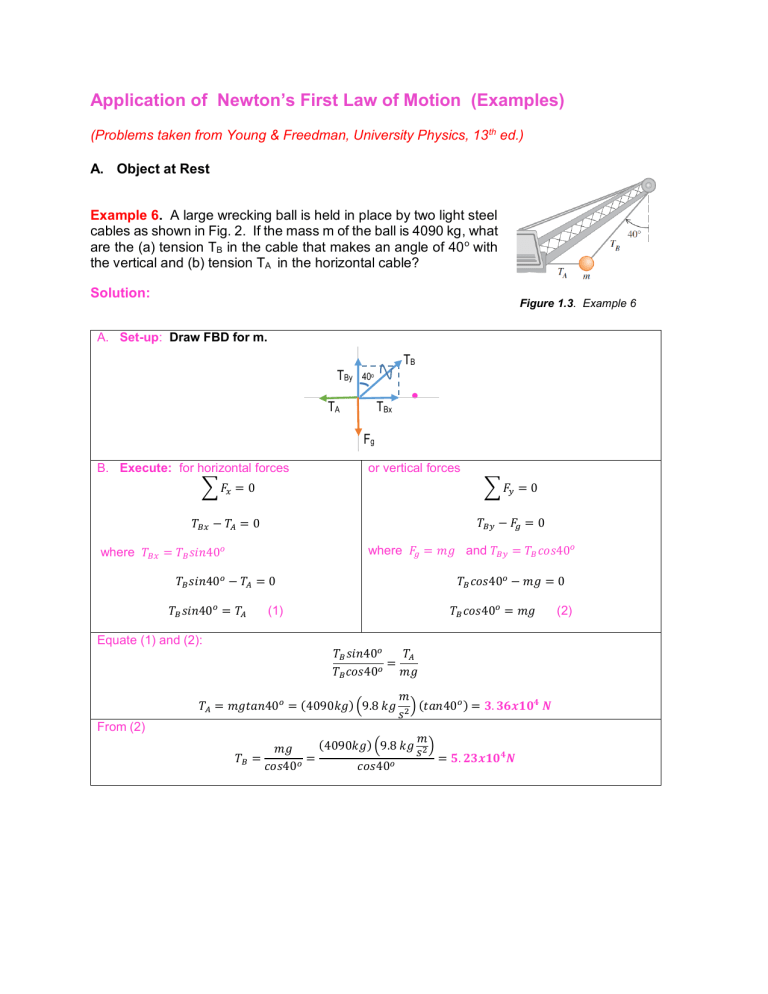
Application of Newton’s First Law of Motion (Examples) (Problems taken from Young & Freedman, University Physics, 13 th ed.) A. Object at Rest Example 6. A large wrecking ball is held in place by two light steel cables as shown in Fig. 2. If the mass m of the ball is 4090 kg, what are the (a) tension TB in the cable that makes an angle of 40 o with the vertical and (b) tension TA in the horizontal cable? Solution: Figure 1.3. Example 6 A. Set-up: Draw FBD for m. TBy TB 40o TA TBx ● Fg B. Execute: for horizontal forces or vertical forces ∑ 𝐹𝑥 = 0 ∑ 𝐹𝑦 = 0 𝑇𝐵𝑥 − 𝑇𝐴 = 0 𝑇𝐵𝑦 − 𝐹𝑔 = 0 where 𝐹𝑔 = 𝑚𝑔 and 𝑇𝐵𝑦 = 𝑇𝐵 𝑐𝑜𝑠40𝑜 where 𝑇𝐵𝑥 = 𝑇𝐵 𝑠𝑖𝑛40𝑜 𝑇𝐵 𝑠𝑖𝑛40𝑜 − 𝑇𝐴 = 0 𝑇𝐵 𝑠𝑖𝑛40𝑜 = 𝑇𝐴 Equate (1) and (2): 𝑇𝐵 𝑐𝑜𝑠40𝑜 − 𝑚𝑔 = 0 𝑇𝐵 𝑐𝑜𝑠40𝑜 = 𝑚𝑔 (1) 𝑇𝐵 𝑠𝑖𝑛40𝑜 𝑇𝐴 = 𝑇𝐵 𝑐𝑜𝑠40𝑜 𝑚𝑔 𝑇𝐴 = 𝑚𝑔𝑡𝑎𝑛40𝑜 = (4090𝑘𝑔) (9.8 𝑘𝑔 From (2) 𝑚 ) (𝑡𝑎𝑛40𝑜 ) = 𝟑. 𝟑𝟔𝒙𝟏𝟎𝟒 𝑵 𝑠2 𝑚 (4090𝑘𝑔) (9.8 𝑘𝑔 2 ) 𝑚𝑔 𝑠 𝑇𝐵 = = = 𝟓. 𝟐𝟑𝒙𝟏𝟎𝟒 𝑵 𝑐𝑜𝑠40𝑜 𝑐𝑜𝑠40𝑜 (2) Example 7. A 1130-kg car is held in place by a light cable on a very smooth frictionless ramp, as shown in Fig. 3. The cable makes an angle of 31.0o above the surface of the ramp, and the ramp itself rises at 25 o above the horizontal. (a) Draw FBD for the car. (b) Find the tension in the cable. (c) How hard does the surface of the ramp push on the car? Figure 1.4. Example 7 car held in place Solution: (a) Set-up: Draw FBD for the car. T – tension in cable FN – normal force T FN Tsin31o ● Tcos31o mgsin25o mgcos25o mg Execute: (b) Net force on car (parallel to the inclined plane) ∑ 𝐹𝑝𝑎𝑟𝑎𝑙𝑙𝑒𝑙 = 0 𝑇𝑐𝑜𝑠 31𝑜 − 𝑚𝑔𝑠𝑖𝑛25𝑜 = 0 𝑚𝑔𝑠𝑖𝑛25𝑜 𝑐𝑜𝑠 31𝑜 𝑚 (1130𝑘𝑔) (9.8𝑘𝑔 2 ) 𝑠𝑖𝑛25𝑜 𝑠 𝑇= 𝑐𝑜𝑠31𝑜 𝑇= 𝑻 = 𝟓𝟒𝟔𝟎𝑵 (c) Net force on car (perpindicular to the inclined plane) ∑ 𝐹𝑝𝑒𝑟𝑝𝑖𝑛𝑑𝑖𝑐𝑢𝑙𝑎𝑟 = 0 𝐹𝑁 + 𝑇𝑠𝑖𝑛 31𝑜 − 𝑚𝑔𝑐𝑜𝑠25𝑜 = 0 𝐹𝑁 = 𝑚𝑔𝑐𝑜𝑠25𝑜 − 𝑇𝑠𝑖𝑛 31𝑜 = 0 𝑭𝑵 = 𝟕𝟐𝟐𝟎𝑵 FN refers to the force the surface of the ramp exerts on the car. B. Objects Moving with Constant Velocity Example 8. A block with mass m 1 is placed on an inclined plane with slope angle 𝛼 and is connected to a second hanging block with mass m 2 by a cord passing over a small, frictionless pulley. The coefficient of static friction is 𝜇𝑠 and the coefficient of kinetic friction between m 1 and inclined plane is 𝜇𝑘 . (a) Find the mass m2 for which m1 moves up the plane at Figure 5. Example 8 constant speed once it is set in motion. (b) Find the mass m2 for which m1 moves down the plane at constant speed once it is set in motion. Solution: Set-up: Draw FBD for each block. a) m1 moves up the plane at constant speed FN T T fk ● mgsin𝛼 mgcos25o ● m1g m2g m1g Block m1 Block m2 where T – tension in cord FN – normal force 𝐹𝑁 = 𝑚1 𝑔𝑐𝑜𝑠25𝑜 𝑓𝑘 = 𝜇𝑘 𝐹𝑁 = 𝑚1 𝑔𝑐𝑜𝑠25𝑜 Execute: Execute: Net force on m2 (parallel to the inclined plane) Net force on m2 ∑ 𝐹𝑝𝑎𝑟𝑎𝑙𝑙𝑒𝑙 = 0 ∑ 𝐹𝑝𝑎𝑟𝑎𝑙𝑙𝑒𝑙 = 0 𝑇 − 𝑚1 𝑔𝑠𝑖𝑛𝛼 − 𝑓𝑘 = 0 𝑇 − 𝑚2 𝑔 = 0 𝑇 − 𝑚1 𝑔𝑠𝑖𝑛𝛼 − 𝜇𝑘 𝑚1 𝑔𝑐𝑜𝑠25𝑜 = 0 𝑇 = 𝑚1 𝑔𝑠𝑖𝑛𝛼 + 𝜇𝑘 𝑚1 𝑔𝑐𝑜𝑠25𝑜 = 0 Equate (1) and (2): (1) 𝑇 = 𝑚2 𝑔 (2) 𝑚2 𝑔 = 𝑚1 𝑔𝑠𝑖𝑛𝛼 + 𝜇𝑘 𝑚1 𝑔𝑐𝑜𝑠25𝑜 𝑚2 = 𝑚1 𝑠𝑖𝑛𝛼 + 𝜇𝑘 𝑚1 𝑐𝑜𝑠25𝑜 = 𝑚1 (𝑠𝑖𝑛𝛼 + 𝜇𝑘 𝑐𝑜𝑠25𝑜 ) (b) m1 moves down the plane at constant speed once it is set in motion. FBD for m1: FN T fk mgcos25o mgsin𝛼 m1g m1g ∑ 𝐹𝑝𝑎𝑟𝑎𝑙𝑙𝑒𝑙 = 0 𝑇 − 𝑚1 𝑔𝑠𝑖𝑛𝛼 + 𝑓𝑘 = 0 𝑇 − 𝑚1 𝑔𝑠𝑖𝑛𝛼 + 𝜇𝑘 𝑚1 𝑔𝑐𝑜𝑠25𝑜 = 0 𝑇 = 𝑚1 𝑔𝑠𝑖𝑛𝛼 − 𝜇𝑘 𝑚1 𝑔𝑐𝑜𝑠25𝑜 = 0 (3) Equate (2) and (3) 𝑚2 𝑔 = 𝑚1 𝑔𝑠𝑖𝑛𝛼 − 𝜇𝑘 𝑚1 𝑔𝑐𝑜𝑠25𝑜 𝑚2 = 𝑚1 𝑠𝑖𝑛𝛼 − 𝜇𝑘 𝑚1 𝑔𝑜𝑠25𝑜 = 𝑚1 (𝑠𝑖𝑛𝛼 − 𝜇𝑘 𝑐𝑜𝑠25𝑜 )

